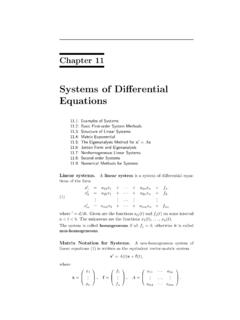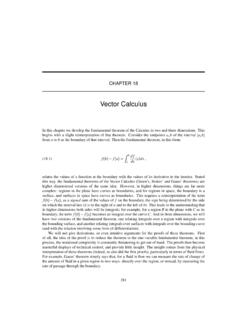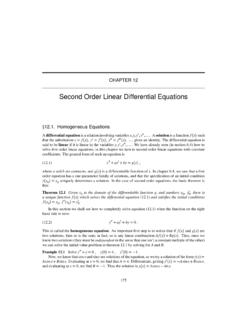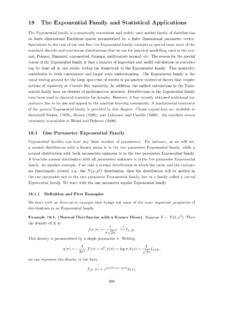Transcription of Laplace Transform - University of Utah
1 Chapter 7 Laplace TransformThe Laplace Transform can be used to solve di erential equations. Be-sides being a di erent and e cient alternative to variation of parame-ters and undetermined coe cients, theLaplace methodis particularlyadvantageous for input terms that are piecewise-de ned, periodic or Laplace transformor theLaplace integralof a functionf(t) de ned for 0 t <1is the ordinary calculus integration problemZ10f(t)e stdt;succinctly denotedL(f(t)) in science and engineering literature. TheL{notation recognizes that integration always proceeds overt= 0 tot=1and that the integral involves anintegratore stdtinstead of theusualdt.}
2 These minor di erences distinguishLaplace integralsfromthe ordinary integrals found on the inside covers of calculus Introduction to the Laplace MethodThe foundation of Laplace theory isLerch's cancellation lawR10y(t)e stdt=R10f(t)e stdtimpliesy(t) =f(t);orL(y(t) =L(f(t))impliesy(t) =f(t):(1)In di erential equation applications,y(t) is the sought-after unknownwhilef(t) is an explicit expression taken from integral , we illustrate Laplace 's method by solving the initial value prob-lemy0= 1; y(0) = 0:The method obtains a relationL(y(t)) =L( t), whence Lerch's cancel-lation law implies the solution isy(t) = methodis advertised as atable lookup method, in whichthe solutiony(t) to a di erential equation is found by looking up theanswer in a special integral Introduction to the Laplace Method247 Laplace integralR10g(t)e stdtis called theLaplaceintegralof the functiong(t).)
3 It is de ned by limN!1RN0g(t)e stdtanddepends on variables. The ideas will be illustrated forg(t) = 1,g(t) =tandg(t) =t2, producing the integral formulas in Table (1)e stdt= (1=s)e st t=1t=0 Laplace integral ofg(t) = 1=sAssumeds > (t)e stdt=R10 dds(e st)dtLaplace integral ofg(t) = ddsR10(1)e stdtUseRddsF(t; s)dt=ddsRF(t; s) dds(1=s)UseL(1) = 1= 1=s2Di (t2)e stdt=R10 dds(te st)dtLaplace integral ofg(t) = ddsR10(t)e stdt= dds(1=s2)UseL(t) = 1= 2=s3 Table 1. The Laplace integralR10g(t)e stdtforg(t) = 1, (1)e stdt=1sR10(t)e stdt=1s2R10(t2)e stdt=2s3In summary,L(tn) =n!s1+nAn ideas of theLaplace methodwill be illus-trated for the solutiony(t) = tof the problemy0= 1,y(0) = 0.
4 Themethod, entirely di erent from variation of parameters or undeterminedcoe cients, uses basic calculus and college algebra; see Table 2. Laplace method details for the illustrationy0= 1,y(0) = (t)e st= e stMultiplyy0= 1bye (t)e stdt=R10 e stdtIntegratet= 0tot= (t)e stdt= 1=sUse Table (t)e stdt y(0) = 1=sIntegrate by parts on the (t)e stdt= 1=s2 Usey(0) = 0and (t)e stdt=R10( t)e stdtUse Table (t) = tApply Lerch's cancellation TransformIn Lerch's law, the formal rule of erasing the integral signsis validpro-videdthe integrals are equal for largesand certain conditions hold onyandf{ see Theorem 2. The illustration in Table 2 shows that Laplacetheory requires an in-depth study of aspecial integral table, a tablewhich is a true extension of the usual table found on the inside coversof calculus books.}
5 Some entries for the special integral table appear inTable 1 and also in section , Table for the direct Laplace Transform produces briefer details,as witnessed by the translation of Table 2 into Table 3 readeris advised to move from Laplace integral notation to theL{notation assoon as possible, in order to clarify the ideas of the Transform 3. Laplace methodL-notation details fory0= 1,y(0) = 0translated from Table (y0(t)) =L( 1)ApplyLacrossy0= 1, or multiplyy0= 1bye st, integratet= 0tot= (y0(t)) = 1=sUse Table (y(t)) y(0) = 1=sIntegrate by parts on the (y(t)) = 1=s2 Usey(0) = 0and (y(t)) =L( t)Apply Table (t) = tInvoke Lerch's cancellation Transform formal properties of calculus integralsplus the integration by parts formula used in Tables 2 and 3 leads to theserulesfor the Laplace Transform .}
6 L(f(t) +g(t)) =L(f(t)) +L(g(t))The integral of a sum is thesum of the (cf(t)) =cL(f(t))Constantscpass through theintegral (y0(t)) =sL(y(t)) y(0)Thet-derivative rule, or inte-gration by parts. See Theo-rem (y(t)) =L(f(t))impliesy(t) =f(t)Lerch's cancellation law. SeeTheorem Example ( Laplace method)Solve by Laplace 's method the initial valueproblemy0= 5 2t,y(0) = : Laplace 's method is outlined in Tables 2 and 3. TheL-notation ofTable 3 will be used to nd the solutiony(t) = 1 + 5t Introduction to the Laplace Method249L(y0(t)) =L(5 2t)ApplyLacrossy0= 5 (y0(t)) =5s 2s2 Use Table (y(t)) y(0) =5s 2s2 Apply thet-derivative rule, page (y(t)) =1s+5s2 2s3 Usey(0) = 1and (y(t)) =L(1) + 5L(t) L(t2)Apply Table 1, (1 + 5t t2)Linearity, page (t) = 1 + 5t t2 Invoke Lerch's cancellation Example ( Laplace method)Solve by Laplace 's method the initial valueproblemy00= 10,y(0) =y0(0) =.
7 TheL-notation of Table 3 will be used to nd the solutiony(t) = (y00(t)) =L(10)ApplyLacrossy00= (y0(t)) y0(0) =L(10)Apply thet-derivative rule toy0, that is,replaceybyy0on page [sL(y(t)) y(0)] y0(0) =L(10)Repeat thet-derivative rule, (y(t)) =L(10)Usey(0) =y0(0) = (y(t)) =10s3 Use Table 1. Then (y(t)) =L(5t2)Apply Table 1, (t) = 5t2 Invoke Lerch's cancellation of the Laplace integralR10e stf(t)dtis known to exist in the sense of the improper integral de nition1Z10g(t)dt= limN!1ZN0g(t)dtprovidedf(t) belongs to a class of functions known in the literature asfunctions ofexponential order. For this class of functions the relationlimt!
8 1f(t)eat= 0(2)is required to hold for some real numbera, or equivalently, for someconstantsMand ,jf(t)j M e t:(3)In addition,f(t) is required to bepiecewise continuouson each nitesubinterval of 0 t <1, a term de ned as advanced calculus background is assumed for the Laplace Transform existenceproof. Applications of Laplace theory require only a calculus TransformDe nition 1 (piecewise continuous)A functionf(t) ispiecewise continuouson a nite interval [a; b] pro-vided there exists a partitiona=t0< < tn=bof the interval [a; b]and functionsf1,f2, .. ,fncontinuous on ( 1;1) such that fortnota partition pointf(t) =8> <>:f1(t)t0< t < t1.
9 Fn(t)tn 1< t < tn:(4)The values offat partition points are undecided by equation (4). Inparticular, equation (4) implies thatf(t) has one-sided limits at eachpoint ofa < t < band appropriate one-sided limits at the ,fhas at worst ajump discontinuityat each partition Example ( exponential order)Show thatf(t) =etcost+tis of expo- nential order, that is, show thatf(t)is piecewise continuous and nd >0such thatlimt!1f(t)=e t= :Already,f(t) is continuous, hence piecewise continuous. FromL'Hospital's rule in calculus, limt!1p(t)=e t= 0 for any polynomialpandany >0. Choose = 2, thenlimt!1f(t)e2t= limt!1costet+ limt!
10 1te2t= 0:Theorem 1 (Existence ofL(f))Letf(t)be piecewise continuous on every nite interval int 0and satisfyjf(t)j M e tfor some constantsMand . ThenL(f(t))exists fors > andlims!1L(f(t)) = :It has to be shown that the Laplace integral offis nite fors > .Advanced calculus implies that it is su cient to show that the integrand is ab-solutely bounded above by an integrable functiong(t). Takeg(t) =M e (s ) (t) 0. Furthermore,gis integrable, becauseZ10g(t)dt=Ms :Inequalityjf(t)j M e timplies the absolute value of the Laplace transformintegrandf(t)e stis estimated by f(t)e st M e te st=g(t):The limit statement follows fromjL(f(t))j R10g(t)dt=Ms , because theright side of this inequality has limit zero ats=1.











